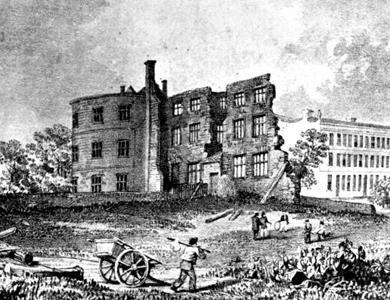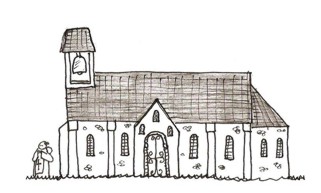Miscellaneous notes on the history of Bridgwater Castle. Also see Robert Dunning’s History here.
Buildings
The Internal Gatehouse

The Chapel of St. Mark

Within Bridgwater Castle was a chapel dedicated to St. Mark. This would have served the spiritual needs of those visiting and working within the castle. This is recorded as having a campanile, a bell-tower, indicating that it was a detached building. [1] Presumably it was of a reasonable size to accommodate seating for William Briwerre’s entourage and his visitors, such as King John. The chapel was spiritually administered by the Bridgwater Hospital of St John, which was probably also founded by Briwerre.[2] The ‘chapel of Seint Marke in the Castell’ was standing in 1535, and a priest celebrated Mass there three times a week. [3] The chapel presumably fell out of use with the dissolution of the Hospital, in 1536. [4] As the castle would not have a private owner for another hundred years, it is unlikely that it was used as a private chapel and, unused, would have fallen to ruin. The location of the chapel is unknown, although it is likely to have been near the most important buildings of the castle, the keep and the hall.
[1] Dilks, Bridgwater Borough Archived 1377-1399, (SRS, 1938) p.x
[2] Parker, G., ‘Proceedings of the Congress’ in the Journal of the British Archaeological Association (Vol. 12, 1856) p.378
[3] Dilks, T. B., ‘Bridgwater Castle and Demesne towards the end of the fourteenth century’ in The Proceedings of the Somerset Archaeological and Natural History Society (vol. 86, 1940) p.105
[4] Cattermole, P.E., ‘The Hospital of St John the Baptist, Bridgwater’ (2005) at [Accessed 27th January 2010]
The Great Hall
In castle architecture the Keep was the lord’s personal residence and there were usually a range of separate buildings, such as a great hall, a chapel and separate accommodation, along with a whole variety of service buildings for the accommodation of guests and their entourages. [1] For Briwerre accommodation had to be fit to entertain the king himself, presumably these buildings in Bridgwater Castle were all of the highest possible standard of the day. There are references to the great hall, called Mortimer’s Hall, in the fourteenth century, although it was presumably one of the first structures to have been built. In 1391 the roof was renewed with fresh timbers and covered in lead.[2] It is interesting that lead was used instead of slate or thatch as on other buildings of the castle. It might be assumed that this building had a lower pitch to say the chapel and barn, and perhaps had battlements. When we look at the Seal of the Commonality therefore (here), the three layers of the castle might represent the curtain wall to the front, the Great Hall behind, with the Keep, the tallest and thinnest of the three, to the rear. However this is merely conjecture.
Thompson suggests the hall was usually the centre of the castle with all subservient buildings arranged according to their relationship to it, although in the case of Bridgwater it is not known where any one of these buildings were. [3] Brown suggests that castles had a function as centres of local government and administration; court would be held in the great hall. [4] During the Mortimer administration the castle and attached manor were run by a steward and hayward. A manor court was held, but there is no indication as to where. It might have been in the great hall as Brown would suggest, but could also have been in the Assize Hall of the town, known distinctly in castle documents as the ‘hall of pleas’. This is perhaps a hangover from when the castle and town were all owned by the Briwerres and not separated, as they had become with the failure of his line. [5] In the 1390s Mortimer’s Hall was being used as a barn, which might suggest that the actual barn was in an unfit state of repair. [6]
[1] Dilks, Brown, A., The Architecture of Castles, (Batsford, London, 1984) pp.66, 71
[2] Lawrence, J. F. & Lawrence, J. C., A History of Bridgwater, (Phillimore, Chichester, 2005) p.21
[3] Thompson, M. W., The Rise of the Castle, (Cambridge University Press, Cambridge, 1991) p.109
[4] Brown, Architecture of Castles, p.107
[5]Lawrence & Lawrence, History of Bridgwater, p.21, Dilks, T. B., ‘Bridgwater Castle and Demesne towards the end of the fourteenth century’ in the Proceedings of the Somerset Archaeological and Natural History Society (vol. 86, 1940) p.96
[6]Dunning, R., ‘Bridgwater Castle’ in A History of the County of Somerset: Vol. 6 (Victoria County History, London. 1992) pp.206-207
Interior

External Articles
Robert Dunning, ‘Bridgwater Castle’
from volume six of the Victoria County History of Somerset (1992)
Select Bridgwater Castle Bibliography
Abbreviations:
SANHS Proceedings of the Somerset Archaeological and Natural History Society
SHER Somerset Historic Environment Record
Archaeology
Anon, ‘West Quay, Bridgwater, 1973’ SANHS (vol. 121, 1976) pp. 101-105
Anon ‘Site 12476’ SHER, [Accessed 5th July 2011
Bridgers, J. L., ‘Report on the Results of an Archaeological Watching Brief to the South of King’s Place, Queen Street, Bridgwater’ (2014) in SHER
Broomhead, R. A., ‘Bridgwater, Queen Street’ (1994) in SHER
Croft, R., ‘Bridgwater, Castle Moat and King Square’ in SANHS vol 132 (1988) p225. Also Plans in SHER HBC/01/08/P7/01 and 02
Ellis, P., ‘Excavations at Friarn Street and West Quay, Bridgwater, 1983/84’ in SANHS (vol 129, 1985) pp 69-80
Langdon, M. & Richardson, F., ‘Castle Moat, King Square, Bridgwater’ in Bridgwater & District Archaeological Society Report (1981) pp. 23-48
Leach, P., ‘Castle Moat, Bridgwater’ (2002) in SHER
Membery, S., ‘Site Visit, 29th April 2004’ in SHER
Place, C., ‘Castle Street, Bridgwater, Somerset’ (2009) in SHER
Sidaway, C., ‘Bridgwater Castle, West Quay’ in SANHS (Vol. 135 1991) pp 169-170
Wright, J. & Chelu, A., ‘The Franciscan Friary and Civil War Defences at Friarn Meadows, Bridgwater’ in SANHS (vol 151, 2007)
Secondary Reading
Ashton, M. & Leech, R., Historic Towns in Somerset, (Sabra Publications, Cheltenham, 1977)
Baker, C. & Baker, M., The Life and Circumstances of James Brydges, first Duke of Chandos, (Oxford University Press, London, 1949)
Cattermole, P.E., ‘Preliminary Notes- The Building Stones of Bridgwater’ (2009) at [Accessed 27th January 2010]
Collinson, A History of Somerset, Vol III (London, 1791)
Dilks, T. B., ‘Bridgwater Castle and Demesne towards the end of the fourteenth century’ in SANHS (vol. 86, 1940) pp. 86-113
Dunning, R., Bridgwater History and Guide, (Alan Sutton, Stroud, 1992)
Dunning, R., ‘Bridgwater Castle’ and ‘Otterhampton’ in A History of the County of Somerset: Vol. 6 (Victoria County History, London. 1992)
Dunning, R., Somerset Castles, (Somerset Books, Tiverton, 1995)
Greswell, W. H., ‘Bridgwater Castle’ in The Ancient Borough of Bridgwater, Powell, A. H. ed, (Page & Son, Bridgwater, 1907) pp. 43-60
Jarman, S. J., A History of Bridgwater, (Elliot Stock, London, 1889)
Lawrence, J. F. & Lawrence, J. C., A History of Bridgwater, (Phillimore, Chichester, 2005)
Parker, G., ‘Proceedings of the Congress’ in the Journal of the British Archaeological Association (Vol. 12, 1856) pp. 376-377
Parker, G., ‘Bridgwater Castle’ in SANHS (Vol 23, 1877) pp 46-47
Powell, A. H., Bridgwater in the Later Days, (Page and Son, Bridgwater, 1908)
Sivier, D., Bridgwater: Personality, Place and the Built Environment, (BAR, Oxford, 2014)
Squibbs, P. J., Squibb’s History of Bridgwater, (Phillimore, Chichester, 1982)
Turner, R., Men Raised From the Dust, (University of Pennsylvania Press, Philadelphia, 1988)
